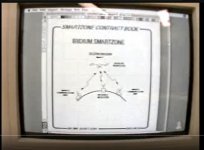This looks like a bunch of inside jokes probably compiled by the people who worked on the project and lived in - or had to travel to - Chicagoland. People used to have fun at work and enjoy themselves back in the day. And, under the Galvin family in the early 90s, Motorola C&E was a great place to work for. I worked for one of the company-owned service centers in the Northeast at the time, but it was one of the most fun and challenging experiences I've ever had in a job (and then they divested the COSCs). Anyway, we would sometimes see skits like this at picnics, gatherings, and other team-building events. Since APCO was mentioned prominently, this may have been a skit production for MTUG (if it existed then), or something for a private hospitality suite gathering at one of the conventions.
I've never seen this, and I don't know all of the in-jokes, but the Iridium one pointed to talk at the time that Iridium, as a satphone network, failed and was going to be de-orbited, essentially flushing all the money invested in it. Later on, Iridium found a purpose in continuity of government type stuff, but its original purpose of being an affordable telephone system that could be integrated into land-based systems to increase coverage never took root. So, the whiteboard skit was a white elephant repurposing of the Iridium constellation into something that supported SmartZone. It didn't, but since it was going to be deorbited at the time, why not figure out a way to make it do SOMETHING?
Around the time, SmartZone was also being developed with various use cases, one of which was to be a nationwide trucker network with really slow-speed data terminals, etc., and had LORAN-C receivers (GPS wasn't a "thing" for another few years yet). And, 900 MHz SmartZone MOSMRs (Motorola Owned SMRs) were experimenting with an ersatz telephone system that was full duplex MRTI. The setup for the phone call was similar to the MRTI semi-duplex dialup, but then the system would activate full duplex voice so the person could use the feature without explaining himself to the other party that was called. But the reality was that nobody wanted a telephone interconnect that only worked in the footprint of one site. So, the SmartZone concept allowed the subscriber to register into the network so that if anyone wanted to make a call, it would be able to do that without additional operator intervention. It wasn't hard, but think about Joe Businessman, buzzed out on martinis, in the back of a limo trying to remember where he was and trying to switch between sites manually.
That somewhat evolved into IDEN a few years later for Morgan O'Brien, which was also an ersatz cellular telephone competitor attempt using TDMA on former SMR frequencies. And, that went on to become the Sprint/NEXTEL and rebanding debacle. SmartZone, itself, eventually went on to be refined as a part of their analog trunked systems. I'm sure there are other ex-Motorolans of the era here (I KNOW there are...) who can chime in and correct me if necessary.


